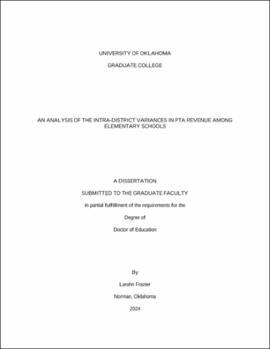| dc.contributor.advisor | Maiden, Jeffrey | |
| dc.contributor.author | Frazier, Larahn | |
| dc.date.accessioned | 2024-04-02T15:09:10Z | |
| dc.date.available | 2024-04-02T15:09:10Z | |
| dc.date.issued | 2024-05-10 | |
| dc.identifier.uri | https://hdl.handle.net/11244/340207 | |
| dc.description.abstract | The purpose of this quantitative resource equity study was to use an equity audit to examine the relationship between intra-district school per-pupil instructional expenditure coupled with per-pupil Parent-Teacher Association (PTA) group revenue at twenty-five elementary school sites in an anonymous suburban school district to determine the effect on the per-pupil instructional expenditure. Many studies reviewed the effect of additional revenue on student performance. Parent-teacher Association revenue was an additional resource for individual schools that is not accounted for in school budgets. The outward appearances of prospering districts can mask intra-district inequities caused by non-profit groups affiliated with each school. Parent-teacher association groups may have a subsidiary effect on equitable activities and spending by further marginalizing students at the elementary school sites within a district.
This study used various equity measurements to assess the revenue variances between per-pupil instructional expenditure and per-pupil PTA revenue at each of the elementary schools in an anonymous suburban school district. Four categories were analyzed: per-pupil instructional expenditure for 25 elementary schools, per-pupil instructional expenditure for 15 elementary schools, per-pupil PTA revenue for 15 elementary schools, and per-pupil instructional expenditure combined with per-pupil PTA revenue for 15 elementary schools. The assumption was per-pupil instructional expenditure and per-pupil PTA revenue would vary between the elementary schools, and those differences were attributed to various predictor variables. The study found low levels of inequity in per-pupil instructional expenditure and moderate inequity in per-pupil PTA revenue. The coefficient of determination and multiple regression found the predictors of gifted/talented percentages, special education percentages, and teacher experience statistically significant in all 25 elementary schools’ instructional expenditure. Only teacher experience was statistically significant in the sub-sample of 15 elementary schools’ instructional expenditure. The predictor variables for the per-pupil PTA revenue and per-pupil instructional expenditure did not have a statistically significant relationship in the sub-sample of 15 elementary schools. The study concluded per-pupil instructional expenditure and per-pupil PTA revenue were statistically inequitable, but the predictor variables varied in statistical significance for the relationships with each of the sub-sample groups.
Keywords:
adequacy
equity
critical resource theory
instructional expenditure
PTA revenue | en_US |
| dc.language | en_US | en_US |
| dc.subject | Intra-district PTA Revenue | en_US |
| dc.subject | Critical Resource Theory | en_US |
| dc.subject | Social Justice Framework | en_US |
| dc.subject | Equity Framework | en_US |
| dc.title | An analysis of the intra-district variances in PTA revenue among elementary schools | en_US |
| dc.contributor.committeeMember | Edwards, Beverly | |
| dc.contributor.committeeMember | Lloyd-Jones, Brenda | |
| dc.contributor.committeeMember | Luévanos, Jose Anthony | |
| dc.date.manuscript | 2024-03-27 | |
| dc.thesis.degree | Ed.D. | en_US |
| ou.group | Jeannine Rainbolt College of Education::Department of Educational Leadership and Policy Studies | en_US |
| shareok.orcid | https://orcid.org/0009-0002-0745-1392 | en_US |
